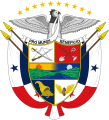
Heraldry is a discipline relating to the design, display and study of armorial bearings, as well as related disciplines, such as vexillology, together with the study of ceremony, rank and pedigree. Armory, the best-known branch of heraldry, concerns the design and transmission of the heraldic achievement. The achievement, or armorial bearings usually includes a coat of arms on a shield, helmet and crest, together with any accompanying devices, such as supporters, badges, heraldic banners and mottoes.
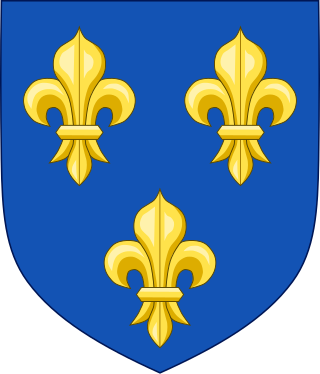
The fleur-de-lis, also spelled fleur-de-lys, is a common heraldic charge in the shape of a lily. Most notably, the fleur-de-lis is depicted on the traditional coat of arms of France that was used from the High Middle Ages until the French Revolution in 1792, and then again in brief periods in the 19th century. This design still represents France and the House of Bourbon in the form of marshalling in the arms of Spain, Quebec and Canada, for example.
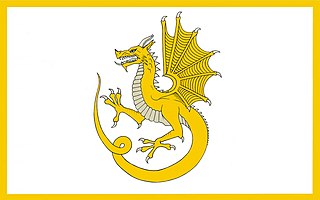
The wyvern is a type of mythical dragon with two legs, two wings, and often a pointed tail which is said to be a venomous stinger.

The coat of arms of England is the coat of arms historically used as arms of dominion by the monarchs of the Kingdom of England, and now used to symbolise England generally. The arms were adopted c.1200 by the Plantagenet kings and continued to be used by successive English and British monarchs; they are currently quartered with the arms of Scotland and Ireland in the coat of arms of the United Kingdom. Historically they were also quartered with the arms of France, representing the English claim to the French throne, and Hanover.

A red star, five-pointed and filled, is a symbol that has often historically been associated with communist ideology, particularly in combination with the hammer and sickle, but is also used as a purely socialist symbol in the 21st century. It has been widely used in flags, state emblems, monuments, ornaments, and logos.

In heraldry, a charge is any emblem or device occupying the field of an escutcheon (shield). That may be a geometric design or a symbolic representation of a person, animal, plant, object, building, or other device. In French blazon, the ordinaries are called pièces, and other charges are called meubles.

The Tudor rose is the traditional floral heraldic emblem of England and takes its name and origins from the House of Tudor, which united the House of Lancaster and the House of York. The Tudor rose consists of five white inner petals, representing the House of York, and five red outer petals to represent the House of Lancaster.
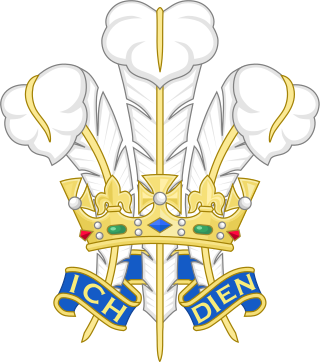
The Prince of Wales's feathers are the heraldic badge of the Prince of Wales, the heir to the British throne. The badge consists of three white ostrich feathers encircled by a gold coronet. A ribbon below the coronet bears the German motto Ich dien. As well as being used in royal heraldry, the feathers are sometimes used to symbolise Wales itself, particularly in Welsh rugby union and Welsh regiments of the British Army.

A cross pattée, cross patty or Pate, or cross paty, also known as a cross formy or cross formée, is a type of Christian cross with arms that are narrow at the centre, and often flared in a curve or straight line shape, to be broader at the perimeter. The form appears very early in medieval art, for example in a metalwork treasure binding given to Monza Cathedral by Lombard queen Theodelinda, and the 8th-century lower cover of the Lindau Gospels in the Morgan Library. An early English example from the start of the age of heraldry proper is found in the arms of Baron Berkeley.

The rose is a common device in heraldry. It is often used both as a charge on a coat of arms and by itself as an heraldic badge. The heraldic rose has a stylized form consisting of five symmetrical lobes, five barbs, and a circular seed. The rose is one of the most common plant symbols in heraldry, together with the lily, which also has a stylistic representation in the fleur-de-lis.

The cross moline is a Christian cross, constituting a kind of heraldic cross.

The lion is a common charge in heraldry. It traditionally symbolises courage, nobility, royalty, strength, stateliness and valour, because historically the lion has been regarded as the "king of beasts". The lion also carries Judeo-Christian symbolism. The Lion of Judah stands in the coat of arms of Jerusalem. Similar-looking lions can be found elsewhere, such as in the coat of arms of the Swedish royal House of Bjelbo, from there in turn derived into the coat of arms of Finland, formerly belonging to Sweden.

Ecclesiastical heraldry refers to the use of heraldry within Christianity for dioceses, organisations and Christian clergy. Initially used to mark documents, ecclesiastical heraldry evolved as a system for identifying people and dioceses. It is most formalized within the Catholic Church, where most bishops, including the Pope, have a personal coat of arms. Clergy in Anglican, Lutheran, Eastern Catholic and Eastern Orthodox churches follow similar customs, as do institutions such as schools and dioceses.

In heraldry and heraldic vexillology, a blazon is a formal description of a coat of arms, flag or similar emblem, from which the reader can reconstruct the appropriate image. The verb to blazon means to create such a description. The visual depiction of a coat of arms or flag has traditionally had considerable latitude in design, but a verbal blazon specifies the essentially distinctive elements. A coat of arms or flag is therefore primarily defined not by a picture but rather by the wording of its blazon. Blazon is also the specialized language in which a blazon is written, and, as a verb, the act of writing such a description. Blazonry is the art, craft or practice of creating a blazon. The language employed in blazonry has its own vocabulary, grammar and syntax, which becomes essential for comprehension when blazoning a complex coat of arms.

In heraldry and vexillology, a heraldic flag is a flag containing coats of arms, heraldic badges, or other devices used for personal identification.

Socialist-style emblems usually follow a unique style consisting of communist symbolism. Although commonly referred to as coats of arms, most are not actually traditional heraldic achievements. Many communist governments purposely diverged from heraldic tradition in order to distance themselves from the monarchies that they usually replaced, with coats of arms being seen as symbols of the monarchs.

The wolf has been widely used in many forms in heraldry during the Middle Ages. Though commonly reviled as a livestock predator and man-eater, the wolf was also considered a noble and courageous animal, and frequently appeared on the arms and crests of numerous noble families. It typically symbolised the rewards of perseverance in long sieges or hard industry.
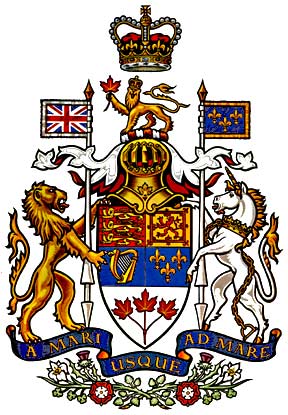
Canadian heraldry is the cultural tradition and style of coats of arms and other heraldic achievements in both modern and historic Canada. It includes national, provincial, and civic arms, noble and personal arms, ecclesiastical heraldry, heraldic displays as corporate logos, and Canadian blazonry.

The royal standards of England were narrow, tapering swallow-tailed heraldic flags, of considerable length, used mainly for mustering troops in battle, in pageants and at funerals, by the monarchs of England. In high favour during the Tudor period, the Royal English Standard was a flag that was of a separate design and purpose to the Royal Banner. It featured St George's Cross at its head, followed by a number of heraldic devices, a supporter, badges or crests, with a motto—but it did not bear a coat of arms. The Royal Standard changed its composition frequently from reign to reign, but retained the motto Dieu et mon droit, meaning God and my right; which was divided into two bands: Dieu et mon and Droyt.

The coat of arms of the Prince of Wales is the official personal heraldic insignia of the Princes of Wales, a title traditionally granted to the heir apparent of the reigning monarch of the United Kingdom of Great Britain and Northern Ireland, formerly the Kingdom of Great Britain and before that the Kingdom of England.



